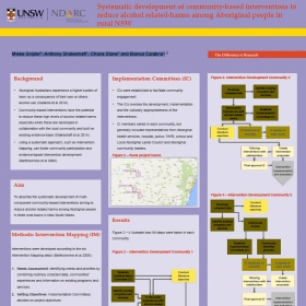This poster was prepared by Mieke Snijder at the 2015 NDARC Annual Research Symposium. Mieke also presented the findings in a five-minute poster presentation.
Abstract
Introduction: Community-based interventions are likely to reduce alcohol related harms among Australian Indigenous people, especially when they are developed in close collaboration with the community. This paper will showcase how a systematic approach was used in partnership with three local communities to develop multi-component interventions aiming to reduce alcohol related harms.
Method: Two types of data were collected: routinely collected hospital admission, emergency department and police data and literary analysis of intervention research. Outcomes of the data collection were discussed in an Implementation Committee which consisted of local service providers, Aboriginal community members and researchers.
Results: The needs assessment showed that young people (17 to 25 years old) were most involved in alcohol related harms, but a lack of appropriate services or opportunities for work, education or alternative entertainment for this group existed in each community.Implementation committees decided the interventions should primarily aim to reduce alcohol related crimes and emergency department presentations and improve community's feelings of safety and empowerment, by focusing on providing at risk young people and their families with better service delivery, alternatives to alcohol use and opportunities for empowerment.Literature searches identified multi-component interventions to be most appropriate to target the identified issues.
The Implementation Committees decided on the implementation of multi-component interventions within three core components: 1) Improved service delivery; 2) Community activities and 3) Improved empowerment. Within each component, the Implementation Committees chose their own programs, appropriate to their community. To promote sustainability, the majority of the interventions were developed within existing services, in collaboration with CBOs.
Conclusion: These results show how researchers can work together with Aboriginal communities in the systematic development of interventions, while using data and evidence based literature.


